Adrian discusses the Club’s involvement with Theoretical Pot and some recent discoveries
Croydon Caving Club’s association with Theoretical Pot goes back many years. In 1980, a survey was produced to the bottom of the 10 metre entrance pitch, which is situated shortly after the rather awkward entrance rift. The survey clearly shows the north-south fault which almost certainly led to the formation of the cave in the first place. The cave I believe was given its name by the University of Bristol Speleological Society.
I believe my first visit to the cave was some 33 years ago in 1991 with Malcolm Stewart. Malcolm wrote in the Croydon CC logbook on 7th September 1991:-
Carried 60lb of timber onto the moor in scorching hot sunshine (mad dogs and scotsmen) and built an anti-sheep /anti-cave-mouth-collapse grid. This was supplemented with a screen made of the old fence. The hole is now sheep- proof. I intend having at least one digging trip to the foot of this fascinating shaft in the future.
And thus the saga of Theoretical Pot began!
On these early 1991 trips, a way on was noticed at the base of the pitch and via a steeply sloping, rubble- filled squeeze, a small chamber was gained and another free-climbable drop. On the 1980 survey, the way into the continuation is marked with the word “dig”, so it is possible that from the base of the pitch we had entered new territory. Malcolm spent some time shoring up this loose drop by building a scaffold structure which he described as being like a Toblerone on end. It was in the small chamber that a stream enters the cave; this stream has never been dye-traced so we still do not know where it goes. It did not take very long, however, to find that the stream at the base of the scaffolded drop disappeared off into a low bedding which soon became much too low to follow.
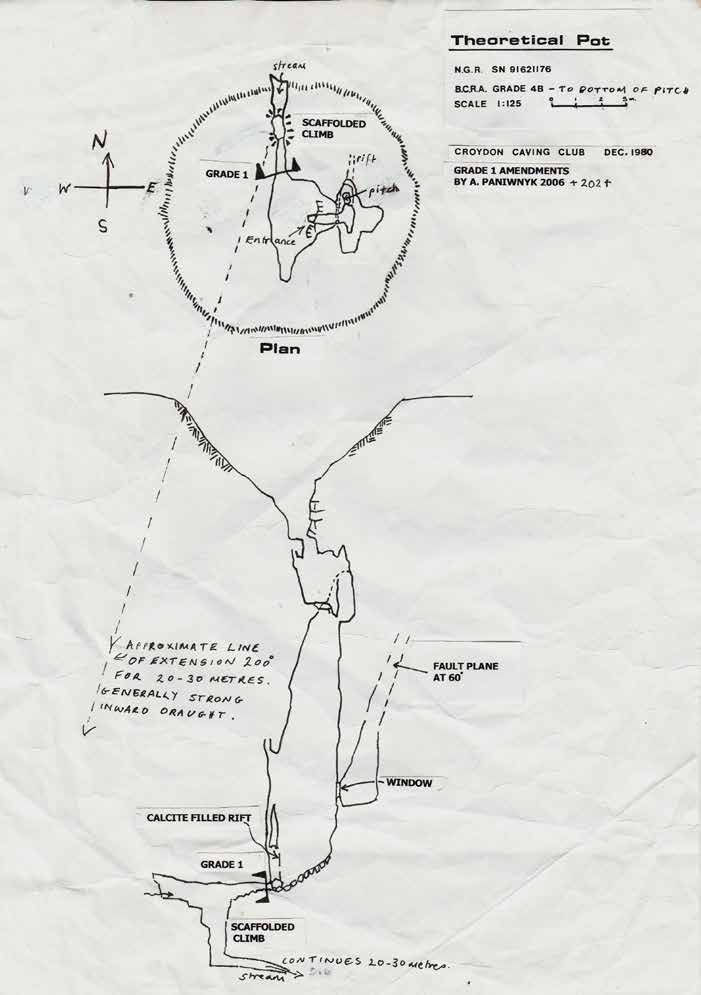
At the start of 1992, attempts were made to chemically enlarge the end of the low bedding. Malcolm reported on 14th March 1992 that the “awkward dog’s front door and environs had totally dissolved.” The spoil produced had to be labouriously dragged back up the scaffolded shaft and stacked in the small space at the top. By the 28th June 1992 the dig was not looking so good, Malcolm wrote in the logbook that he could see the terminal rift carrying on for at least 10 feet at only 6 inches high in solid rock. He wrote at the end of his entry “ I think, I’ve finished with this one, although I may go back and pull out some of the scaffolding, wire etc.” Malcolm being a man of his word did not return. Myself not quite wanting to admit defeat, made a few solo trips to try and continue enlarging the bedding with SLB and caps. However, with minimal progress, I was even forced to admit defeat. And thus Theoretical Pot languished unvisited for a very long time.
It was not until 2019 that Malcolm - who was now back again caving with renewed enthusiasm - suggested that we might like to make a return. Not being able to think of anything else better to do, I said yes. With newer forms of technology we might be able to make some more progress. Things did not get off to a very good start, for when we first trekked up to the deep shakehole Theoretical pot is situated in, it could be clearly seen that mud and rubble had slipped down one side and covered the entrance. Using scaffolding and some road crash barriers purchased by Malcolm, a weekend was spent clearing the collapse to regain the awkward entrance rift and pitch. When we finally got round to descending the pitch, we assumed that the end of the dig was close at hand. However, as so often happens in caves, what you expect is not what you get. It soon became clear that the shakehole slump had not only blocked the entrance but a lot of mud and rubble had somehow made its way to the bottom of the pitch, blocking the way into the squeeze by several feet. Not having run out of enthusiasm yet, we started digging down again, installing scaffolding with a tin sheet behind it, in order to retain the mud and rubble. Again, this was not so straightforward as every time we visited it seemed to be raining and with a constant stream of water falling down the pitch onto us we were soon wet and cold. In addition, the stream of drips soon found their way to the bottom of the hole we were digging, filling it up with a foot or so of water. Soon, we left blindly trying to extract the mix of stony porridge from the bottom of the pool and throw it over the tin sheet and scaffolding retaining wall. The only thing going for the dig was that we had an old cable to follow which I assumed would lead us back to where we had last been in the 90s. After several digging sessions where little progress seemed to be made, I started to doubt we were on the right track. Finally, in drier conditions a sudden collapse against one side of the solid wall where we were digging revealed an undercut and void. With a bit more enlargement, we were finally back to the squeeze and the scaffolded drop.
Main Pitch Theoretical Pot - Malcolm Stewart
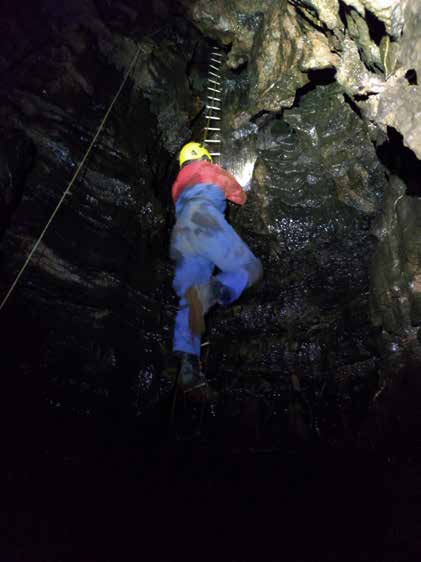
A quick look at the terminal bedding showed that unsurprisingly it had not got any larger in the intervening years. However, with renewed levels of enthusiasm, we set about enlarging it. Those responsible for doing this aside from myself and Malcolm were Peter Hamilton and Gareth Davies. Numerous trips followed, and they mainly ran along similar lines. The mission being, for the first person whilst lying flat out in the stream, to clear as much spoil from the bedding. The drag tray filled with spoil then being pulled back to the base of the scaffolded drop and manhandled to the top by the second person and dumped in the rapidly shrinking space. Occasionally, we had a third person who stood at the top of the drop and helped haul the tray to the top of the drop. All this being done before somebody in the wet and draught started to succumb to the onset of hypothermia.
Dig in Theoretical Pot to regain the rest of the cave - Malcolm Stewart
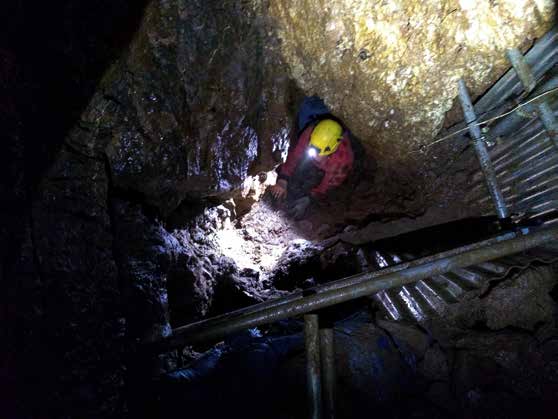
Gradually, the bedding started to enlarge, however, frustratingly it was just that bit too small to squeeze along. More attempts were made to enlarge the passage, mainly by trying to chisel away the ceiling or floor with Malcolm’s drill but even after this it was just too small. Once again people’s enthusiasm started to wane, and as so many years before, I found myself having to do solo trips. One such trip was on 10th March 2023. I was not expecting to make much progress, however, squeezing forward as far as I could, I managed to throw a stone forward and hear the magical sound of it clattering down a small drop, where the floor stepped down a few feet ahead. With renewed enthusiasm, I managed to prize some more rocks out of the floor and also partially chisel away and awkward projection. After all this, I decided to have a go at finally passing the bedding so I wriggled forward. Fortunately, not thinking too much about what would happen if I became hopelessly stuck or there was no room to turn around! After a short while of thrutching, I was amazed to reach the lip of the drop with not as much difficulty as expected and I clearly saw a small but negotiable passage leading off into the distance. As well as this once through the squeeze, I could see the roof lifted briefly to stooping height so I could use this as a handy turning round space.
After all the effort to pass the bedding which had begun over 30 years ago as you can imagine I was in jubilant mood. Squirming forward on my side, I set off down the passage; although not quite expecting caverns measureless to man, I was hoping the passage went for a reasonable distance. Sadly, however, any dreams of this happening were quickly snuffed out. After about 10 metres I reached a pile of boulders partially blocking the passage and just beyond that the passage closed down to a rift that was too tight to follow. However, on the bright side, the rift was not so tight that it looked like a hopeless digging proposition.
I was not in S.Wales the next weekend but Malcolm after the news of the small breakthrough decided to take a look with his wife Helen. On this trip, the pile of rocks just prior to the constriction were broken up using plugs and feathers. Obviously, the aim of the next trip with Malcolm was to see if the constriction could be passed. After a failed attempt at trying to cap the rift, we returned to the tried and tested method of trying to chisel bits of the wall using Malcolm’s drill. This was successful enough in that after several hours of chiseling and thrutching back down the rift with the spoil, I felt that I might be able to fit through.
Malcolm Stewart trying to fit through the dig we started in the 90s. The section in front of him all had
to be enlarged as it was only 6 inches high! - Peter Hamilton
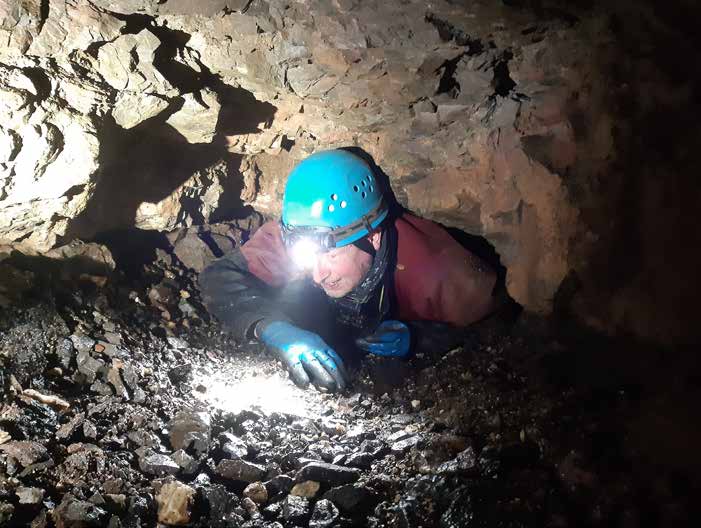
Malcolm, by now after several hours of relative inactivity, was now starting to get cold, so I thought that if I was going to attempt to get through the squeeze I’d better get on with it. Without telling Malcolm what I was planning to do, I wriggled my way up the rift and then managed to post myself through the tightest section at the end. I popped out into a slight widening of the passage, oddly enough he didn’t seem too enthusiastic when I told him the good news!
The passage beyond the squeeze continued low and flat out for several metres. Reaching a point beyond a corner, I realised that I would have to start clearing rocks and cobbles out of the floor to make any further progress; I decided that I better see if I could return to Malcolm. I reversed back down the passage and in a a slight enlargement after some frantic contortions managed to turn round and come back through the squeeze head first.
The passage after the breakthrough on 10th March 2023 - Peter Hamilton
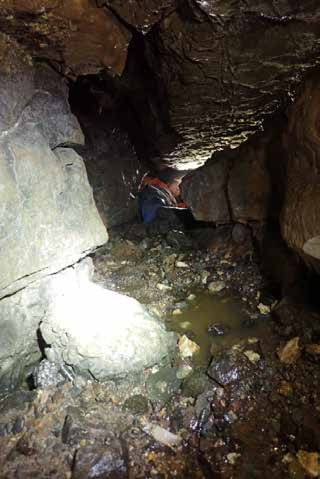
Subsequent trips minus Malcolm followed, these initially entailed stacking rocks into any available alcoves so that I might be able to wriggle further forward. Doing this a few more metres of progress was made, until the overhung walls pinched in again. However, by shining my light carefully through the gap, it was just possible to see that there might be an enlargement beyond. Again, I returned to chiseling. It was particularly hard going as there was barely room enough to just lie still, let alone swing a hammer. I was grateful that Peter was on one of these trips but I imagine he might have thought otherwise about coming if he had known that one section of the wall whilst being hammered would detach itself and temporarily trap his helmet with his head in it! After a shriek from Peter and a moments panic on my part, thinking he might be injured, fortunately he managed to extricate head and helmet unscathed. Knowing what happened to Peter, when I came to deal with the wall on the other side, I was not totally surprised when a large section also decided to detach itself, however, being forewarned I managed to keep my head out of the way when it came crashing down.
The large rock which trapped Peter’s helmet! - Peter Hamilton
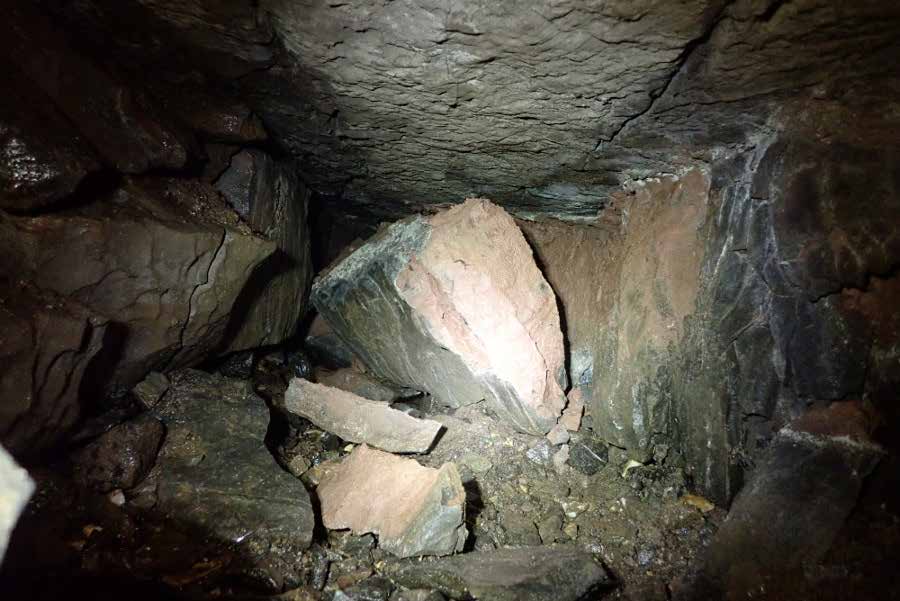
We now had two large blocks which had been part of the walls now on the floor and still blocking the passage. We started to break these up, however as there was no stacking space behind , most of the rock had to be thrown into where the passage dropped down slightly ahead. The result of this was that when we finally reached the point where somebody might be able to squeeze through our “enlargement” had been filled up with spoil and was no more.
The day I finally got through I was again by myself. I squeezed over the pile of spoil to see the small stream flowing away on my right, down a passage which was much too small to follow. All together disappointing considering the amount of effort that had been put in! To my left there was a small enlargement where the ceiling rose somewhat which could be used to stack spoil, however, this would be quickly filled up once you started enlarging the rift. Then there was absolutely no stacking space for at least 10 metres back down the flat out passage. The next suitable spot being back through the squeeze.
The passage after the second squeeze - getting tighter! - Peter Hamilton
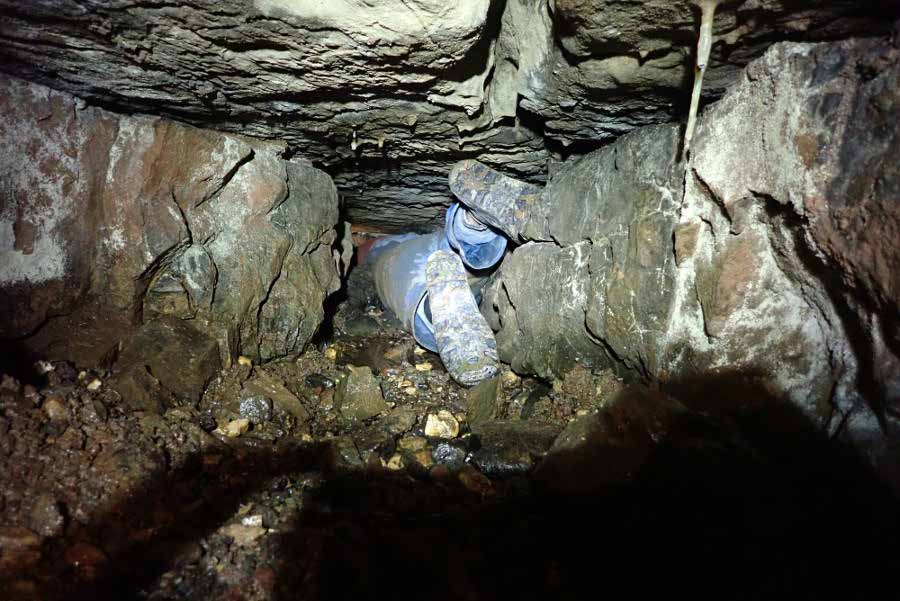
I left the cave in a fairly despondent mood. Then it did occur to me, that if I knew the small passage I had seen enlarged almost straight away after the constriction, it just might be worth carrying on. So the next trip saw me trudging up the hill with camera and drain rods and other paraphernalia necessary to look down tight passages. Once I had managed to get the kit to the end of the cave and put it together-not without some difficulty- it soon became clear that the passage remained tight for 2 metres and then went round an almost 90 degree corner. I tried jiggling and twisting the drain rods around to hopefully get the camera in such a position to see round the bend but all attempts to this were to no avail. I had even brought a string to tie to the endoscope camera to aid the jiggling process but in the awkward circumstances I had not attached it. In the strong draught, I was now feeling very cold and with chattering teeth I packed up the kit and headed out the cave.
The too tight terminal constriction with drain rod and tackle bag for scale - Adrian Paniwnyk

Subsequent to this Andrey Kozhenkov with my help tried to produce an up date survey of the cave. However, on this day it was to be carried out the weather had been wet and due to the amount of spray in the cave we were unable to get the Distox measuring device to work properly. It is for this reason that the survey shown is that from 1980 with a few BCRA grade 1 amendments. The line of the extension is on an angle of approximately 200 degrees. If the cave carried on this alignment it would be due to connect with the North- East Inlet series in Little Neath River Cave, however, there is still a gap of several hundred metres between the two.
As mentioned previously the passage discovered has a strong inward draught which at most times of the year blows inwards. In this respects it might be worth doing a draught test and seeing if a connection might be shown to a nearby shakehole or surface feature.For the time being work in Theoretical Pot has been abandoned. The constricted nature of the passage discovered and that there is little or no stacking space means that those who carry on will face a difficult proposition. What is needed is a team of small pushy cavers but I’m not too sure where to find them or even if they exist anymore!